Platypus should be listed as a threatened species, new report says
by University of New South Wales
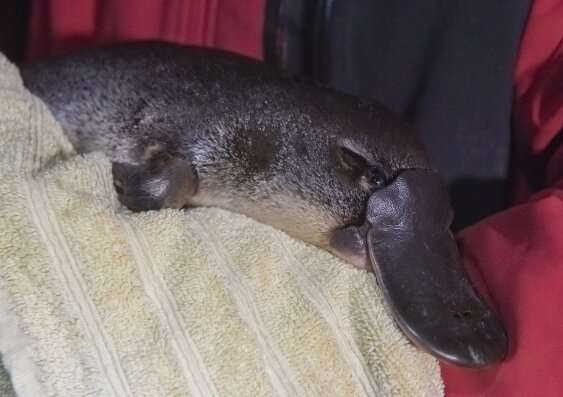
In NSW, the number of platypus observations declined by around 32 per cent in the last 30 years. Credit: Stuart Cohen
A landmark assessment by scientists at UNSW Sydney recommends the platypus be listed as a threatened species under Australia's and NSW environmental legislation.
The UNSW researchers, along with the Australian Conservation Foundation, WWF-Australia and Humane Society International Australia, today submitted their recommendations to the Commonwealth and NSW Government's scientific committees.
The International Union for Conservation of Nature (IUCN) Red List currently lists the iconic species as 'Near Threatened' – but it is not listed as threatened under Australia's Environment Protection and Biodiversity Conservation (EPBC) Act.
For their assessment, a team of researchers from the Centre for Ecosystem Science (CES) at UNSW collated all available data and evidence and assessed the species' risk of extinction against IUCN and EPBC criteria.
The scientists find that the area of eastern Australia where platypuses are found has shrunk by up to 22 percent, or about 200,000 km2, over the past 30 years.
"We recorded the most severe declines in platypus observations in NSW—particularly in the Murray-Darling Basin, where natural river systems and water flows have been the most heavily modified," says UNSW's Dr. Tahneal Hawke, a lead author of the report.
In NSW, the number of platypus observations declined by around 32 percent in the last 30 years, compared to 27 percent in Queensland. In Victoria, even though the state-wide decline was around 7 percent, the researchers observed reductions in numbers of as much as 54-65 percent in some urban catchments near Melbourne.
The scientists' models predict that platypus populations may have declined by more than 50 percent as a result of historic land clearing, river regulation, and extreme droughts—some of the major threats affecting the species. Platypuses also drown in closed freshwater yabby traps, which are still legally sold in NSW and Queensland.
"The platypus continues to face ongoing threats across its range. Unsustainable water extraction and land clearing will continue to put pressure on freshwater ecosystems and drive future declines in the future," says UNSW's Dr. Gilad Bino, a lead author.
The changing climate also presents a serious threat to platypuses, with more severe droughts, reduced rainfall and intense fires drying out rivers, reducing water quality, and destroying the riparian vegetation.
Listing the platypus as threatened would increase the scrutiny placed on developments that might endanger the species and prioritize its monitoring.
"It would also mean an increased focus on what we can do to improve the situation," Professor Kingsford, CES director, says.
The scientists say protecting one of the world's most iconic animals and the rivers it relies on must be a national priority.
"We have a national and international responsibility to look after this unique animal and the signs are not good. Platypus are declining and we need to do something about threats to the species before it is too late," Prof. Kingsford says.
Explore further Researchers warn of uncertain future for the platypus
Australia: Scientists push to list platypus as threatenedNumbers of the vulnerable duck-billed species, unique to Australia, have dropped by more than a fifth since 1990. Extreme droughts linked to climate change threaten the platypus' existence, scientists have warned.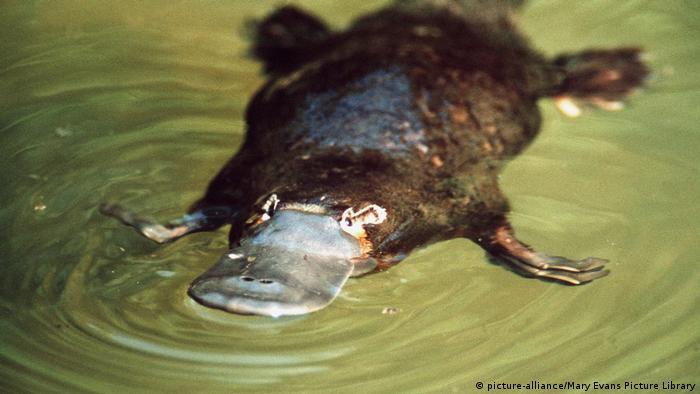 Scientists have called for the Australian native platypus to be listed as a "threatened species" after a report found the habitat of the semi-aquatic duck-billed mammal had shrunk by up to 22% over the past 30 years.Researchers from the University of New South Wales (UNSW) said severe drought brought by climate change, land clearing for farming and dam building are to blame. "The platypus continues to face ongoing threats across its range. Unsustainable water extraction and land clearing will continue to put pressure on freshwater ecosystems and drive future declines in the future," lead author Gilad Bino said Monday, adding that increased severity and occurrence of bush fires is also likely to have contributed to the platypus's decline.Droughts pose serious threatThe beaver-tailed, webbed-feet platypus live mostly across Australia's eastern coast, close to rivers and streams. They cannot live outside water. As Australia dries further, their habitat could get even smaller, the scientists warned.Richard Kingsford, director of UNSW's Centre for Ecosystem Science, said that platypus populations "will disappear from some of our rivers without returning, if rivers keep degrading with droughts and dams."Read more:'Wildfires are climate fires': How to talk about climate emergency, global heatingCurrently, the platypus is listed as "near threatened" by the International Union for Conservation of Nature, but it is not listed as threatened under Australia's Environment Protection and Biodiversity Conservation Act.Changing its listing would prioritize its monitoring and "also mean an increased focus on what we can do to improve the situation," Kingsford said.VIDEO
Scientists have called for the Australian native platypus to be listed as a "threatened species" after a report found the habitat of the semi-aquatic duck-billed mammal had shrunk by up to 22% over the past 30 years.Researchers from the University of New South Wales (UNSW) said severe drought brought by climate change, land clearing for farming and dam building are to blame. "The platypus continues to face ongoing threats across its range. Unsustainable water extraction and land clearing will continue to put pressure on freshwater ecosystems and drive future declines in the future," lead author Gilad Bino said Monday, adding that increased severity and occurrence of bush fires is also likely to have contributed to the platypus's decline.Droughts pose serious threatThe beaver-tailed, webbed-feet platypus live mostly across Australia's eastern coast, close to rivers and streams. They cannot live outside water. As Australia dries further, their habitat could get even smaller, the scientists warned.Richard Kingsford, director of UNSW's Centre for Ecosystem Science, said that platypus populations "will disappear from some of our rivers without returning, if rivers keep degrading with droughts and dams."Read more:'Wildfires are climate fires': How to talk about climate emergency, global heatingCurrently, the platypus is listed as "near threatened" by the International Union for Conservation of Nature, but it is not listed as threatened under Australia's Environment Protection and Biodiversity Conservation Act.Changing its listing would prioritize its monitoring and "also mean an increased focus on what we can do to improve the situation," Kingsford said.VIDEO Dry weather threatens another iconic Australian species
In the Cerrado, topography explains the genetic diversity of amphibians more than land cover
by André Julião, FAPESP

Study shows that a tree frog endemic to a mountainous region of the Brazilian savanna is unable to disperse and find genetically closer mates when the terrain is rugged, potentially endangering survival of the species Credit: Renato C. Nali
The savanna tree frog Bokermannohyla ibitiguara is about 4 cm long and is found only in gallery forest along streams in the Serra da Canastra mountain range in the state of Minas Gerais, Southeast Brazil. In this watery forest environment, it can grow, feed, mate, and lay eggs without needing to range very far throughout its life cycle, according to a study published in Diversity and Distributions.
According to the Brazilian and US researchers who conducted the study, topography rather than vegetation is the main factor leading to more or less dispersal of the species in the territory, and this information is even recorded in its DNA.
They analyzed genetic variation among groups of B. ibitiguara living inside and outside the Serra da Canastra National Park, a protected area in the region, discovering that the flatter the terrain, the more genetically diverse is the population.
In areas of highly variable elevation, individuals are genetically similar. In evolutionary terms, this can be harmful to the species, which becomes more susceptible to disease and climate change, for example.
"Genetic analysis and conservation studies typically take land cover into account, among other factors, but the Cerrado [Brazilian savanna] is topographically diverse, including montane regions with high plateaus [chapadões] separated by low areas. We set out to verify whether this variable terrain played a part in the genetic diversity of the species, and found that it did. The vegetation alone didn't explain the genetic differences we identified between sites, or even within the same site. The topography did," said Renato Christensen Nali, first author of the article and a professor at the Federal University of Juiz de Fora's Institute of Biological Sciences (ICB-UFJF) in Minas Gerais, Brazil.
The study was one of the results of Nali's doctoral research, conducted at São Paulo State University's Bioscience Institute (IB-UNESP) in Rio Claro, Brazil, with a scholarship from FAPESP (São Paulo Research Foundation).
The research was part of the project "Reproductive ecology of anuran amphibians: an evolutionary perspective", for which the principal investigator is Cynthia Peralta de Almeida Prado, a co-author of the article. She is a professor at UNESP's School of Agrarian and Veterinary Sciences in Jaboticabal and teaches graduate students in zoology at IB-UNESP in Rio Claro.
The flatter the better
"The findings are very interesting because they bring to light a novel factor for conservation of the Cerrado, among other reasons. Ecological corridors and native forests are rightly considered important for conservation units, but more attention needs to be paid to the type of terrain. The topography should permit dispersal of the animals," said Nali, who heads ICB-UFJF's Amphibian Evolutionary Ecology Laboratory (Lecean).
To arrive at the results, the researchers analyzed 12 populations of B. ibitiguara, six inside Serra da Canastra National Park and six outside. Genetic diversity was much higher among the anurans living in the protected area than among those living outside the park. When the researchers correlated information on the degree of protection of the areas with the state of the vegetation, they found that these factors were less decisive for genetic diversity than the topography.
"The terrain is much more rugged outside the park, whereas inside it there's a large, very even plateau where the anurans can disperse more, find mates in more distant areas, and increase their genetic diversity," Nali said. "Outside the park, the rugged terrain and variable elevation appear to confine them to small areas."
The influence of these factors was evidenced by genetic tests. The researchers used a technique known as macrosatellite marker analysis to examine specific regions of the genome and found higher allele diversity in the populations living in the park. Allele diversity is one of the determinants of genetic integrity and adaptive potential.
In addition, the populations living outside the park displayed a greater loss of heterozygosity. If this loss, which is associated with declining genetic variability, recurs across several generations, it can eventually threaten the population's survival.
The study underscores the importance of topography as a factor to consider in conservation studies, as well as showing how the mere presence of a species in an area cannot ensure that it is not endangered.
"Molecular analysis enables us to find out if a population's genetic status is favorable," Nali said. "An area may have a large number of individuals, but DNA analysis may show that its genetic constitution is unfavorable, with few alleles and low heterozygosity. In practice, therefore, the population's effective size is small."
Although the study focused on only one species, he added, the findings can apply to others as well since the physical characteristics associated with dispersal are similar for other frogs and toads. More species need to be investigated to confirm the applicability of the findings.
The group noted that land cover nevertheless remains an important factor for conservation in the Cerrado, more than 50% of which has been converted into pasture or cropland, while less than 5% is protected by conservation units.
Explore further Elephant genetics guide conservation
More information: Renato C. Nali et al, Topography, more than land cover, explains genetic diversity in a Neotropical savanna tree frog, Diversity and Distributions (2020). DOI: 10.1111/ddi.13154
The secret origins of China's 40-year plan to end carbon emissions
by Bloomberg News
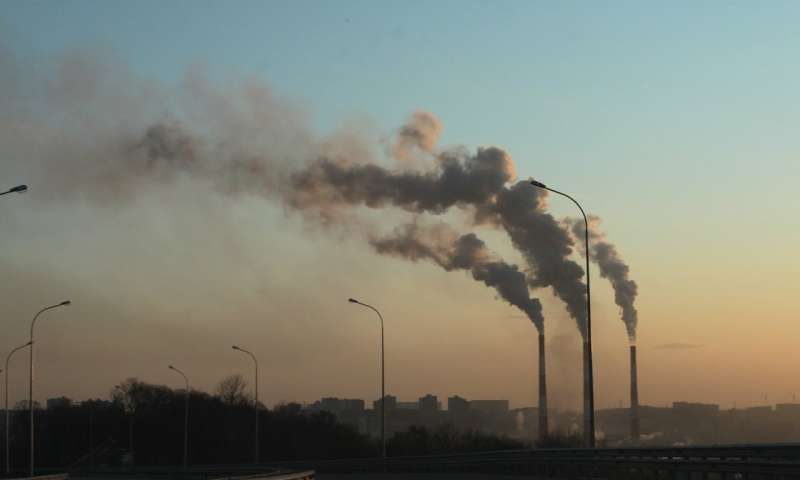
Credit: CC0 Public Domain
The biggest emitter of planet-warming pollution managed to take almost the whole world by surprise. In a September speech to the United Nations, Chinese President Xi Jinping put a 2060 end date on his country's contribution to global warming. No other nation can do more to keep warming below the 1.5C threshold set in the Paris Agreement. Yet diplomats, climate activists and even policy experts inside China for the most part had not anticipated this pivotal turnabout.
Just days before Xi's U.N. appearance, in fact, European leaders including European Commission President Ursula von der Leyen and German Chancellor Angela Merkel had pressed him directly on a videoconference to follow the EU's example in setting a climate-neutrality goal. Notes from the call reviewed by Bloomberg Green indicate that Xi gave no hint he was about to abandon China's long-established policy against climate restrictions on economic growth.
Inside China, meanwhile, experts who specialize in the intricacies of emissions policy were stunned by Xi's speech. "Can this goal be achieved?" asked a bewildered post on WeChat from a retired climate negotiator in Beijing. Most stakeholders with a hand in previous climate decisions had been kept out of the loop, according to interviews with more than a dozen industry groups, environmentalists and government researchers in China. But the decision to completely reorient a gigantic economy that's dominated by coal, at the cost of trillions of dollars, didn't come from nowhere.
The secret drive for China's 2060 target took shape inside Tsinghua University, where climate scientists had quietly spent more than a year modeling different pathways to reach net zero. Xie Zhenhua, a former environmental bureaucrat and veteran diplomat, oversaw the work from his threadbare office as head of the college's Institute of Climate Change and Sustainable Development. Few within China's strict hierarchy can match Xie's mastery of government bureaucracy and climate science, making him an influential voice on the issue among the ruling elite.
Xie is modest about his role. "We made policy proposals to relevant leaders and departments," he says in an interview on Tsinghua's campus in late October, dressed like a typical Communist Party cadre in a dark suit and pressed white shirt. "It seems our proposals had some impact."
China and other developing nations had long held that wealthier countries that benefited from earlier industrialization, heedless of the dangers from burning fossil fuel, should carry most of the economic burden for preventing catastrophic warming. Xie spent more than a decade as China's top climate diplomat, in the early years fiercely defending the principle that emerging economies have a right to uncontrolled carbon emissions. On a population-adjusted basis, after all, far too much carbon dioxide began its journey into the atmosphere from smokestacks and tailpipes in the U.S. and Europe.
At the 2011 international climate talks in Durban, South Africa, Xie gave a table-pounding speech calling out the hypocrisy of developed nations; news footage made him famous throughout China. Now at the twilight of his career, he has done more than anyone else outside Xi's ruling circle to position China as a global climate leader, establishing a carbon neutrality plan ahead of the U.S.
"When you first start, it's just a job," Xie says. "But after some time, when you see the impact you could bring to the country, the people, and the world, it is no longer just a job. It has become a cause, a higher calling."
At 71, Xie should be happily retired after more than three decades shaping China's approach to the climate and environmental protection. Communist Party custom requires members of Xie's rank who turn 70 to relinquish official roles. A rare exception allowed him to receive an appointment as special adviser to the environment ministry this year.
In that capacity, Xie submitted the 2060 recommendations based on research his institute had done in coordination with a dozen government-linked think tanks. The proposal likely arrived on Xi's desk via Vice Premier Han Zheng, who sits on the Politburo's Standing Committee and oversees the environment ministry.
Every major decision in China is made collectively by the seven men on the Standing Committee. Ultimate credit invariably goes to Xi, the nation's most powerful leader since Mao Zedong. Environmental protection has become one of Xi's core issues as he has sought to temper the growth-at-all-costs mentality that dominated China's breakneck industrialization.
Before the U.N. speech, though, Xi had never spoken publicly about carbon neutrality. The proposition was considered so remote that it was hardly mentioned by state media. "China was reluctant to talk about concepts like net-zero emissions or carbon neutrality," says Li Shuo, a prominent environmentalist in China who has spent years lobbying Xie for more aggressive policies. "Xie has played a part in bridging that gap."
To translate global climate imperatives into Chinese government policy, you need to be fluent in two extremely esoteric languages: sloganeering Communist Party-speak on the one hand, and the technocratic vocabulary of international climate negotiation on the other. That's how Xie manages the trick of advocating for the greater commitments other countries want from China without making them seem like concessions.
Examples of this unusual ability pop out of Xie's interview: The 2060 goal, he says, will help China become a "great modern socialist power" and build "a community with a shared future for mankind," mottos Xi has used to guide long-term policymaking. Then, code-switching effortlessly, he explains that China's stance on "mitigation, adaptation, financing and technology" will still need to be discussed at next year's COP26 U.N. Climate Change Conference, at which nations work out the details of the Paris Agreement.
Xie's career has traced China's meteoric economic rise—and its reckoning with the damage left behind. His tenure as the head of China's environment protection administration ended abruptly in 2005 after deadly explosions at a chemical plant in Jilin, a province near the border with North Korea and Russia. The accident affected tens of millions of people.
Such an incident would have derailed the career of a typical civil servant, but Xie bounced back and eventually ended up on the Communist Party Central Committee. He took over the role as China's primary international climate negotiator in 2007, and his approach didn't always resort to denouncing developed nations. A former colleague jokingly described him as "like a panda bear, very huggable."
"When you come to the negotiation table, you need to be honest and candid. People respect you for protecting your own country's interests," Xie says, looking back. "But you're also here to solve problems, to tackle climate change."
He clashed publicly with Todd Stern, the U.S. special climate envoy from 2009 to 2016, before hammering out a bilateral agreement in 2014 that brought China into the Paris Agreement two years later. Leaked emails from the period show the two negotiators reminiscing like old friends, discussing future visits and grandchildren. "He's somebody that I could always trust and somebody who I can do business with," Stern said in a telephone interview from Washington.
"This is a very meaningful task," Xie says. "A climate negotiator has only rivalries and friends, but he has no enemies."
Days after Xi addressed the U.N., the Tsinghua scientists were ready to present their roadmap to 2060. The plan called for a gradual energy transition over the next decade and a half, followed by a rapid acceleration requiring an almost sevenfold increase in solar energy and a near quintupling of nuclear power. Some analysts worried about this two-speed approach. The incremental start defers the hardest decisions until 2035, for the next generation.
This gradual trajectory to net zero probably helped Xie's plan face less pushback from top officials, according to two green activists who have worked with him. (They asked not to be identified, as activists in China are often targeted by the government for criticizing official policy.) The activists said a more ambitious short-term move, such as accelerating China's 2030 target for reaching peak emissions, would have likely provoked a backlash.
China has also given itself a 10-year buffer, as most other major economies are working toward net-zero emissions by 2050. This group includes the EU as well as Japan and South Korea, which swiftly followed Xi's U.N. announcement with pledges of their own. The U.S. could be next, with President-elect Joe Biden calling for a 2050 target.
There's risk that the extra decade for China will increase the temptation by policymakers to postpone painful changes. The grand vision for 2060 will have to be filtered through hundreds of official documents, beginning with the government's next five-year plan to be released in March. Different ministries, local governments and state-owned enterprises will then work the policies into their own blueprints, where things could get watered down or delayed.
Xie believes the 2060 target will force short-term changes. "The goal will be difficult or even impossible to reach if we rely on traditional technologies and maintain traditional ways of production, of living and consumption," he says. "This sends out a clear signal: We have to transform fast and innovate big."
It's not climate skepticism that drives the resistance. Chinese schoolchildren are taught the science of global warming from a young age, and citizens are eager for the government to clean up the polluted air and water. The main issue is the coal industry. China mines and burns half the world's supply, and the sector still supports tens of millions of jobs.
After Xi endorsed the Paris Agreement, the Chinese coal industry launched a nationwide campaign to retrofit power plants with what it claims to be low-emission technology. This effort was publicly endorsed by influential academics, and that support in turn gave the coal industry cover to build new plants. On the very same day Xi addressed the U.N., a commentary in the People's Daily, a Communist Party mouthpiece, argued for the future of coal: "As long as coal is utilized in a clean and efficient way, it should be called clean energy."
Xie thinks this time will be different. "The ultra low-emission (coal) technology might have resolved the problems of air pollution and energy efficiency, but it can't solve the problem of CO2 emissions," he says. "Now that President Xi has made public the goal, I believe people will start to see the investment risks there."
With the next round of global climate talks coming up in Glasgow, Scotland, and countries under pressure to boost their commitments, China stands to gain a lot of goodwill by coming out of the gate early with a bold declaration. Turning the pledge into a domestic priority will be a challenge as the government faces pressure to keep its post-pandemic economic recovery going.
But it won't come down to choosing between climate action and growth. China suffered record floods in 2020 that affected more than 70 million people and caused some 214 billion yuan ($33 billion) in economic losses. "The damage done by climate change is not in the future," Xie says, "but right here, right now."
Explore further China's new coal plants risk 2060 climate target: researchers
©2020 Bloomberg News
Distributed by Tribune Content Agency, LLC
Nature's toolkit for killing viruses and bacteria
by American Physical Society

Credit: Unsplash/CC0 Public Domain
They burst out of toilet bubbles, swim across drinking water, spread through coughs. Tiny infectious microbes—from the virus that causes COVID-19 to waterborne bacteria—kill millions of people around the world each year. Now engineers are studying how zinc oxide surfaces and natural hydrodynamic churning have the power to kill pathogens first.
"Bacterial contamination of common surfaces and of drinking water have been traditionally the main infection routes for transmission of serious diseases, often leading to mortality," said Abinash Tripathy, a researcher in mechanical and process engineering at ETH Zurich. "Our goal was to design a surface that can address both issues."
His group submerged clean zinc in hot water for 24 hours, which formed a zinc oxide surface covered in sharp nanoneedles. Then they introduced E. coli bacteria.
The surface kills almost all bacteria cultured on top of it very efficiently. And the biggest surprise? When sitting in contaminated water, the surface kills all waterborne E. coli within three hours—even bacteria it didn't touch.
This water disinfection at a distance works because the process generates a reactive oxygen species, which damages the cell walls of bacteria. The group from ETH Zurich, IIT Ropar India, and Empa, Switzerland, presented their initial findings at the 73rd Annual Meeting of the American Physical Society's Division of Fluid Dynamics.
In Southeast Asian and African countries where clean drinking water is scarce, current solar water disinfection methods take up to 48 hours and require a minimum intensity of sunlight. The new zinc oxide surface speeds up the disinfection process and does not need light.
"This surface can be used to disinfect water in remote areas at a very low cost," said Tripathy. "The fabrication technique is environmentally friendly, simple, and economical."
Surface and waterborne pathogens aren't the only killers. As the COVID-19 pandemic has reinforced, airborne viruses and bacteria pose a serious global challenge for disinfection.
The very droplets that carry pathogens through the air can play a role in destroying them. In the microseconds that droplets take to form, their fluids rearrange rapidly—stressing the microbes within.
"Think of a bucket with a fish in it. One imagines that if you start churning the fluid in the bucket too quickly, the fish won't be very happy," said Oliver McRae, a mechanical engineer. "It's a similar kind of thing—albeit on a much, much smaller scale—when you have, say, a pathogen in a droplet. Eventually the fluid's going to agitate too much for that bacteria or virus to survive."
McRae and a team from Boston University and the Centers for Disease Control and Prevention were studying how hydrodynamic agitation works when environmental bubbles produce droplets. After the onset of the pandemic, they started modeling droplets similar to those produced by the lungs and respiratory tract.
Using computational fluid dynamics, the team predicted how agitation works during aerosol formation. They discovered that stressors are very sensitive to droplet size. If the droplet shrinks or grows by one order of magnitude, the stressors change by two-and-a-half orders of magnitude.
The research could help explain why pathogens survive in some droplets and not others.
"Our focus has been on quantifying what the stressors are in these droplets," said McRae. "Hopefully this will be used in the future as part of a larger model to predict aerosol-based disease transmission."
Explore further Engineers devise new method to remove harmful E. coli from water
Research evaluates effectiveness of conservation efforts
by University of Stirling
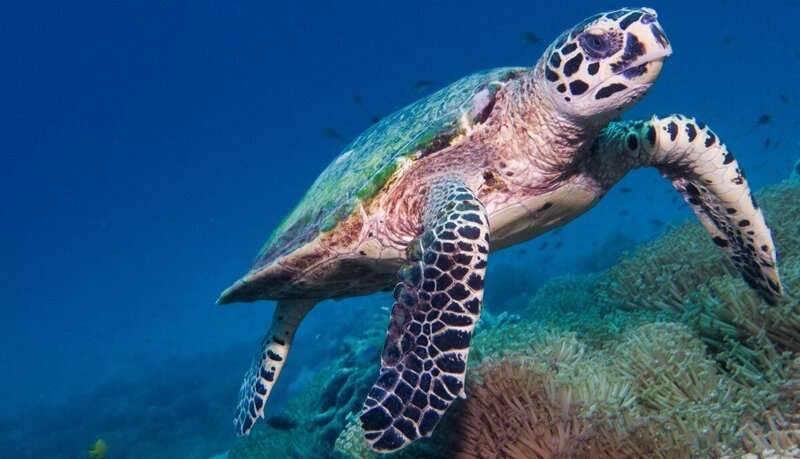
Credit: University of Stirling
New research from the University of Stirling into the effectiveness of international conservation projects could help to save endangered species from extinction.
The research, led by Laura Thomas-Walters of the Faculty of Natural Sciences, has published in respected journal, People and Nature. It focussed on evaluating a conservation campaign in São Tomé and Principe, that aimed to persuade local people to stop eating sea turtle meat and eggs.
Animal conservation faces a number of challenges, including climate change and the wildlife trade, and both time and money pressures. Knowing what measures work best and are most appropriate is essential to delivering effective conservation activity, but previous efforts to evaluate projects have encountered difficulties and delivered varying results.
The Stirling research team sought to address those difficulties by exploring better ways to evaluate conservation projects that work to change human behavior. The team conducted interviews and completed surveys with local people to determine if the campaign, which used tactics including television advertisements and cooking competitions, had been successful in reducing their consumption of sea turtles.
Laura Thomas-Walters, research project lead, said: "In conservation we are faced with a whole host of pressing issues that human actions cause, but we are short on time and money. Evaluating our projects is really important if we want to learn from them and improve future interventions.
"Unusually, for this research we measured both behavioral outcomes like attitudes or consumption, and conservation impacts, like sea turtle poaching. We found a decrease in self-reported sea turtle egg consumption and a decrease in the poaching of adult sea turtles.
"However, a simultaneous increase in law enforcement targeted at poaching may also have impacted the figures. Our recommendations for future projects include combining different outcome measures to triangulate hard-to-measure behaviors, and using theory-based evaluation methods."
The campaign, 'Tataluga—Mém Di Omali', which means "Sea Turtle—Mother of the Sea" in the local Forrô dialect featured community events, such as cooking contests to promote alternative food products, and theater performances, as well as a football competition. It also utilized mass media, including billboards, and television and radio adverts.
The Stirling team interviewed local people about their habits and sea turtle consumption, both before and after the campaign took place. The number of people who indicated they ate sea turtle eggs decreased from 40 per cent to 11 per cent during the campaign but this may also have been due to increased anti-poaching law enforcement.
Explore further Tracking sea turtle egg traffickers with GPS-enabled decoy eggs
More information: Laura Thomas‐Walters et al, Challenges in the impact evaluation of behaviour change interventions: The case of sea turtle meat and eggs in São Tomé, People and Nature (2020). DOI: 10.1002/pan3.10162
COVID-19 is just one factor impacting wellbeing of employees working from home, study finds
by University of Exeter

Credit: CC0 Public Domain
A new study on work-life balance has found that the COVID-19 crisis is a crucial factor—but not the only one—behind low levels of wellbeing among employees working from home.
A research team including Professor Ilke Inceoglu, professor of organisational behaviour and HR management at the University of Exeter Business School, analysed data from 835 university employees, who completed a baseline questionnaire on wellbeing and took a weekly survey.
The preliminary results, which are being prepared for peer review, found that around 38% of home-workers felt anxious most or all of the time while death levels went up during the early stages of the first COVID-19 lockdown, with 8% saying they felt depressed.
The handling of the pandemic by government and employers was found to make those working from home more anxious and less enthusiastic about their jobs, and job insecurity, as a result of the economic impact of lockdown, also had a negative impact on wellbeing.
But the loneliness of working in a home environment and increased demands to juggle work and domestic responsibilities also caused a decline in employee wellbeing, the study found.
Nearly one in five (17%) remote workers reported feeling lonely, while around a quarter (25.9%) said that the competing demands of work and domestic duties (including childcare) had taken their toll.
Other aspects of remote working that contributed to a lower standard of wellbeing included increased job insecurity, the unpredictability of future workloads, new ways of working and a lack of support from employers.
The research team claims that these factors not only impact on wellbeing but also hamper employees' ability to make decisions and concentrate—15% said they found it hard to make many decisions on their own and 21% could not decide how to go about doing their work.
Professor Inceoglu said: "Our research is important in that it adds to the story of COVID but it also enables us to assess the role of location and whether the COVID-19 pandemic factors over and above conventional job design factors, which is indeed not the case."
Professor Stephen Wood, from the University of Leicester Business School and Principle Investigator of the study, added: "The pandemic has contributed to short term fluctuations in the wellbeing of employees working at home, but the factors that affect all jobs, the extent of job discretion, potential loneliness of working alone, and job insecurity remain important and is likely to remain so after the pandemic."
The results of the study were presented at an ESRC Festival of Social Science webinar on Friday 13 November.
Explore further The future of work is flexible, says new study
Siberian primrose has not had time to adapt to climate change
by University of Helsinki

Siberian primrose. Credit: Marko Hyvärinen
Siberian primrose, a species protected under the Habitats Directive of the European Union, spread northward from southern areas to the current Bothnian Bay as well as, through another route, to northern Norway with the gradually receding ice after the Ice Age. Compared to today, the warming of the climate was very slow at the time.
"Siberian primrose is specialized in growing on seashore meadows with low vegetation, which in Finland are formed by the post-glacial isostatic rebound. The species benefits from the lack of strong competitors and grazing that keeps the vegetation low," says Marko Hyvärinen, director of the Botany Unit of the Finnish Museum of Natural History, University of Helsinki.
In 2013, researchers at the Universities of Helsinki and Oulu planted both the Norwegian and Finnish varieties (Primula nutans ssubp. finmarchicha var. finmarchica and var. jokelae) at five different botanic gardens—in their home environments in Svanvik, northern Norway, and in Oulu, northern Finland, as well as in Rauma and Helsinki further south in Finland and in Tartu, Estonia.
As expected by the researchers, both varieties fared poorer in the southern gardens compared to Oulu and Svanvik, indicating that a warmer climate may be fatal for the species if it is incapable of adapting or relocating.
"We were surprised, however, by our finding that the Finnish populations were more successful in northern Norway than in Oulu—even more successful than the Norwegian variety there, in its home environment," says Postdoctoral Researcher Maria Hällfors from the Research Centre for Ecological Changeat the Faculty of Biological and Environmental Sciences, University of Helsinki.
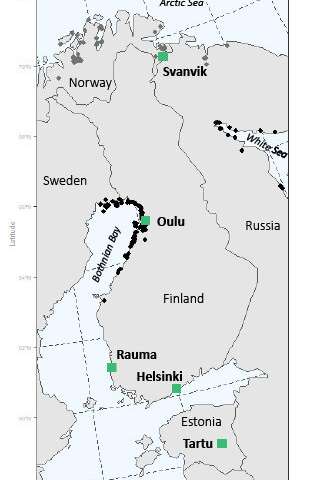 Five botanical gardens in which Siberian primroses from Norway and Finland were planted. Credit: University of Helsinki
Five botanical gardens in which Siberian primroses from Norway and Finland were planted. Credit: University of Helsinki
"This indicates that global warming already affects this plant species. We can only speculate how many other species are suffering from changes to their environment, if they, too, are unable to keep up with climate change," Hällfors says.
The researchers suggest that the poor adaptability of Siberian primrose in relation to global warming may contribute to the demise of these populations.
"Siberian primrose has no natural dispersal route further north. One way to help species like this to survive current and future challenges would be to relocate them, by human hand, further north. In other words, species could be protected by what is known as assisted migration," Hällfors says.
Another option is to ensure that species have sufficiently large high-quality habitats to preserve populations at a viable level. This would ensure enough genetic variation within the populations, that is, different individuals that have a higher probability to posit characteristics that are suitable in the new conditions.
"In any case, investments in ex situ conservation, or the conservation of species outside their natural habitat, are needed. As an example, seeds of a species can be stored in a seed bank from where the species could be re-introduced to nature," Hällfors notes.
Explore further
More information: Maria Hällfors et al. Translocation of an arctic seashore plant reveals signs of maladaptation to altered climatic conditions, PeerJ (2020). DOI: 10.7717/peerj.10357
Scientists organize to tackle crisis of coral bleaching
by Laura Arenschield, The Ohio State University
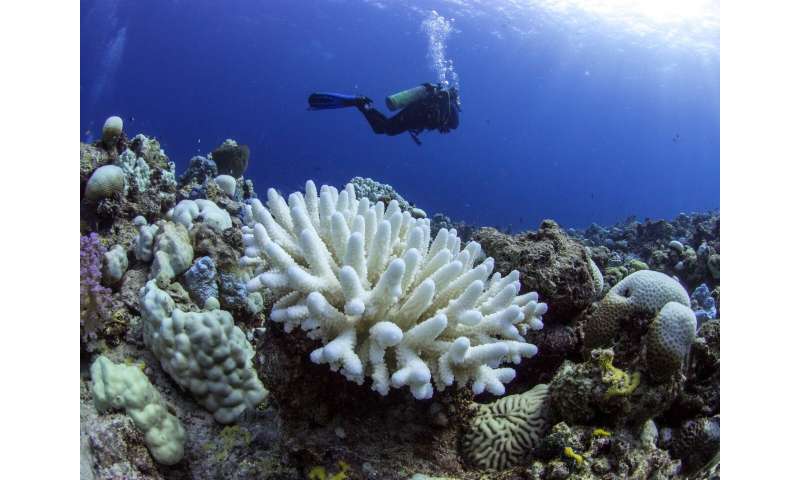
Bleached coral in the Red Sea. Credit: Anna Roik
An international consortium of scientists has created the first-ever common framework for increasing comparability of research findings on coral bleaching.
"Coral bleaching is a major crisis and we have to find a way to move the science forward faster," said Andréa Grottoli, a professor of earth sciences at The Ohio State University and lead author of a paper on guidelines published TBD in the journal Ecological Applications.
The common framework covers a broad range of variables that scientists generally monitor in their experiments, including temperature, water flow, light and others. It does not dictate what levels of each should be present during an experiment into the causes of coral bleaching; rather, it offers a common framework for increasing comparability of reported variables.
"Our goal was to create a structure that would allow researchers to anchor their studies, so we would have a common language and common reference points for comparing among studies," said Grottoli, who also is director of the consortium that developed the common framework.
Coral bleaching is a significant problem for the world's ocean ecosystems: When coral becomes bleached, it loses the algae that live inside it, turning it white. Coral can survive a bleaching but being bleached puts coral at higher risk for disease and death. And that can be catastrophic: Coral protects coastlines from erosion, offers a boost to tourism in coastal regions, and is an essential habitat to more than 25% of the world's marine species.
Bleaching events have been happening with greater frequency and in greater numbers as the world's atmosphere—and oceans—have warmed because of climate change.
"Reefs are in crisis," Grottoli said. "And as scientists, we have a responsibility to do our jobs as quickly, cost-effectively, professionally and as well as we can. The proposed common framework is one mechanism for enhancing that."
The consortium leading this effort is the Coral Bleaching Research Coordination Network, an international group of coral researchers. Twenty-seven scientists from the network, representing 21 institutions around the world, worked together as part of a workshop at Ohio State in May 2019 to develop the common framework.
The goal, Grottoli said, is to allow scientists to compare their work, make the most of the coral samples they collect, and find ways to create a common framework for coral experimentation.
Their recommendations include guidelines for experiments that help scientists understand what happens when coral is exposed to changes in light or temperature over a short period of time, a moderate period, and long periods. The guidelines include a compendium of the most common methods used for recording and reporting physical and biological parameters in a coral bleaching experiment.
That such a framework hasn't already been established is not surprising: The scientific field that seeks to understand the causes of and solutions for coral bleaching is relatively young. The first reported bleaching occurred in 1971 in Hawaii; the first wide-spread bleaching event was reported in Panama and was connected with the 1982-83 El Niño.
But experiments to understand coral bleaching didn't really start in earnest until the 1990s—and a companion paper by many of the same authors found that two-thirds of the scientific papers about coral bleaching have been published in the last 10 years.
Researchers are still trying to understand why some coral species seem to be more vulnerable to bleaching than others, Grottoli said, and setting up experiments with consistency will help the science move forward more quickly and economically.
"Adopting a common framework for experiments around coral bleaching would make us more efficient as a discipline," Grottoli said.
"We'd be able to better collaborate, and to build on one another's work more easily. It would help us progress in our understanding of coral bleaching—and because of climate change and the vulnerability of the coral, we need to progress more quickly."
Explore further Guam avoids severe coral bleaching predicted for this year
More information: A.G. Grottoli et al, Increasing comparability among coral bleaching experiments, Ecological Applications (2020). DOI: 10.1002/eap.2262
3-D printed corals, new bioreactors to boost microalgae production for biofuels
by Fintan Burke, From Horizon Magazine, Horizon: The EU Research & Innovation Magazine
 The structure of coral polyps provide an ideal habitat for colonies of Symbiodinium sp. algae to grow. Credit: Dr Wangpraseurt
The structure of coral polyps provide an ideal habitat for colonies of Symbiodinium sp. algae to grow. Credit: Dr Wangpraseurt
Using light as an energy source, photosynthetic microalgae can be used to produce products like biofuels and cosmetics. But algae grown in a reactor block out the light on which they feed. New reactor designs could solve this problem and help the industry move forward.
Photosynthetic algae—tiny algae that use light to grow—offer an alternative to traditional fossil fuels. The small amount of lipids each cell produces can be harvested to produce biofuel for the transport industry.
Currently, there are two main designs to grow the algae: either through an outdoor artificial 'pond' or through a closed 'photobioreactor' – usually a transparent tube or bag.
Both have their problems. Although an open pond can be big enough for industrial production, it is difficult to control the pond's temperature and the water can easily get infected with unwanted bacteria.
An indoor photobioreactor reduces both these risks, but few designs can be used for industrial production. In both types, the photosynthetic microalgae begin to block out the light as they grow.
"Often what you have is too much light at the surface of the culture and too little light as you go deeper," said Dr. Daniel Wangpraseurt, a marine scientist at Cambridge University in the UK, who is researching how best to grow microalgae.
Efficiently producing biofuels starts by finding the best way possible to grow microalgae. "What we would like to do is to use a strain that produces lots of lipids that can then be converted to biodiesel," said Dr. Wangpraseurt. The better a strain can grow in a bioreactor, the larger the yield of biofuel.
Coral reefs
Dr. Wangpraseurt and his BioMIC-FUEL project took inspiration from how microalgae grow on tropical coral reefs. By recreating coral structures, he and his team hoped to recreate the best conditions for biofuel production.
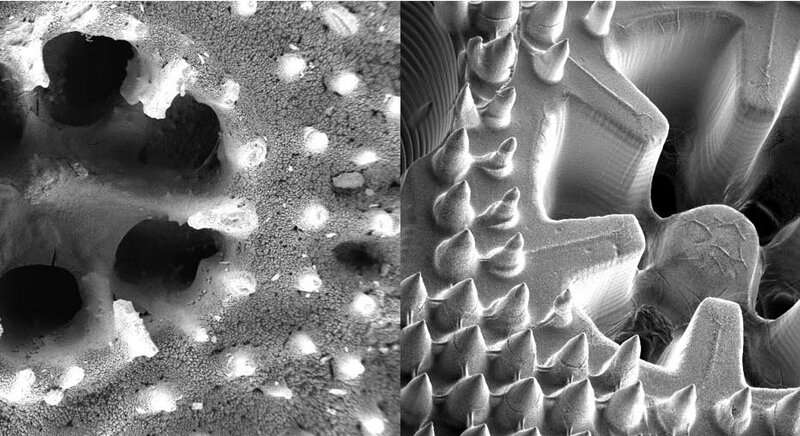
The skeleton structure of the coral Stylophora pistillata (left) is reflected in the 3D printed material (right). Credit: Dr Wangpraseurt
As Dr. Wangpraseurt explains, these corals have a unique structure that allows photosynthesising algae to thrive in an environment with a lot of competition for space and light. For example, the coral skeleton is made from calcium carbonate, which allows the coral to scatter light in a way that it can reach dense microalgae growing on it.
The next step was to create a 3-D printing technique that could replicate the shape of corals, including their unique light-scattering chemical structure. This involved working with bioengineers with expertise in 'printing' cells in artificial organ research.
Researchers investigating how to recreate liver tissue were able to advise Dr. Wangpraseurt's team on how to recreate fine structures and details found on the surface of corals. A 'bio-ink' loaded with nutrients and chemicals was designed to help the microalgae grow well within the 3-D tissue construct.
"There's lots of different things that end up in this cocktail that we call bio-ink—one of the most time-consuming aspects was to tune this bio-ink to be beneficial for the growth of the algae," said Dr. Wangpraseurt.
This allowed them to create artificial structures that had similar strength, softness, and light-scattering qualities as natural corals. After finding the right mix, Dr. Wangpraseurt and colleagues were able to grow microalgae up to 100 times as dense as those found in natural corals.
Dr. Wangpraseurt says that work is underway to optimise the technology and scale it up so that businesses can use it.
Light
Right now, businesses looking for an indoor bioreactor still have few options—the technology still runs into problems such as controlling the light and nutrients in the reactor, and minimising contamination risk.
"Companies in the past tried solving this issue and have come to some solutions, but not something at scale," says Yonatan Golan, the CEO of Brevel, a small company based in Israel developing a large-scale photobioreactor.
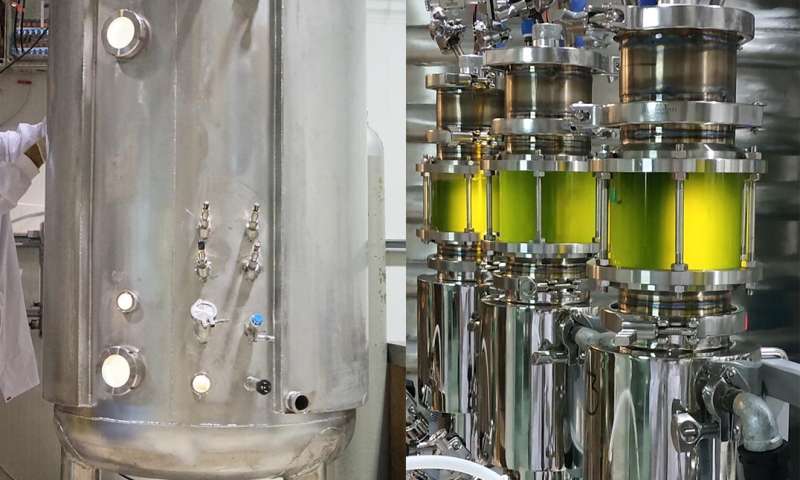
A large bioreactor (left) and smaller labscale bioreactors (right). Credit: Yonatan Golan, Brevel
As Golan explains, adding lights into the reactor creates extra niches for unwanted bacteria to grow and contaminate the reactor. Extra cleaning elements can be installed in the reactor, though this then causes shadows within the bioreactor, reducing the amount of light for the microalgae.
Brevel's bioreactor design uses patented lighting and cleaning techniques to illuminate the photobioreactor inside while reducing the risk of infection by bacteria. The new lighting techniques mean that light in the reactor can be both smaller and brighter, without heating up the bacterial mixture. Digital image analysis and online monitoring means that the Brevel photobioreactor is also more automated than other photobioreactors available to industry.
Their results are already promising. They were able to reduce the cost of growing photomicroalgae by 90% and produce yields 200 times higher than state-of-the-art outdoor photobioreactors.
Salmon
The bioreactor has applications beyond biofuel. Salmon grown in fish farms do not have the pink colour seen in the wild. To compensate, salmon farmers add an artificial pigment called astaxanthin to feed that gives farmed salmon meat a pinkish hue.
As Golan explains, this synthetic pigment is made from petrochemicals, which researchers note is not approved to be directly consumed by people, though is safe to eat in farmed fish. This pigment constitutes 10% of the final price of salmon.
The scaled-up Brevel bioreactor can make this same pigment at the same price organically, and at the same price as the synthetic version. Organically made pigment is also proven to be safe to eat directly and is naturally higher in antioxidants. Its price is likely to fall as time goes on, Golan adds. The company is also looking at producing products for the nutrition and cosmetics industry.
Next year, Golan hopes to build the first photobioreactor factory and hire more engineers. He believes that microalgae also make sustainable business sense.
"We can actually make a profit from the high value (nutrition and cosmetics) products and be left with the biomass which contains proteins and lipids," he said. "These can be either for the protein market, or it's possible to produce biofuel from them."
Explore further 3-D-printed corals could improve bioenergy and help coral reefs
Climate change presents new challenges for the drinking water supply
by Helmholtz Association of German Research Centres
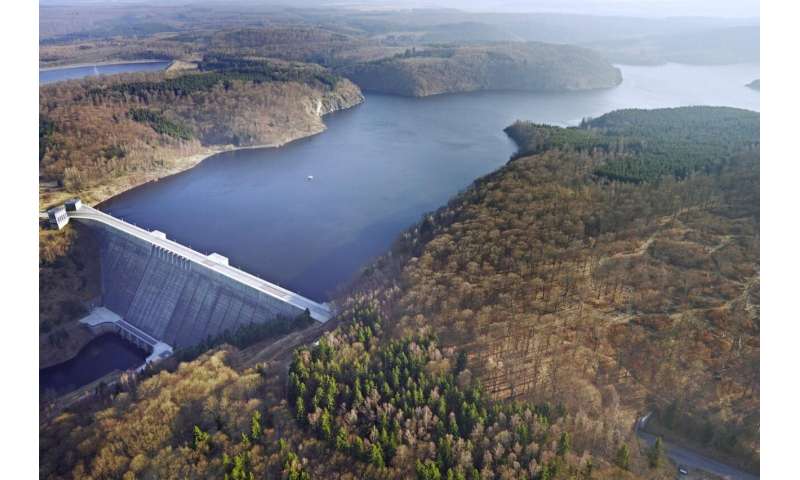
The Rappbode Reservoir in the Harz region is Germany's largest drinking water reservoir. Credit: André Künzelmann
The Rappbode Reservoir in the Harz region is Germany's largest drinking water reservoir, supplying around one million people with drinking water in areas including the Halle region and the southern part of the state of Saxony-Anhalt. Water temperatures in the reservoir now have the potential to increase significantly due to climate change. If average global warming reaches between 4 and 6 degrees by the year 2100, as the current trend suggests, temperature conditions in the Rappbode Reservoir will become comparable to those in Lake Garda and other lakes south of the Alps. In an article in Science of the Total Environment magazine, a team of researchers led by the Helmholtz Centre for Environmental Research (UFZ) writes that the reservoir's operators could partially offset the impacts this will have on the drinking water supply—to do so, they would have to change the way the reservoir is managed.
The impacts of climate change can already be seen in the Rappbode Reservoir: Over the past 40 years, the water surface temperature in the reservoir has increased by around 4 degrees in the summer months. This trend could continue, as has now been demonstrated by a team of researchers led by Dr. Karsten Rinke, who researches lakes at UFZ. Working on the basis of a lake model developed by US researchers, the team took into account potential reservoir management strategies to forecast the impacts climate change could have on water temperatures and on the lake's physical structure, which control the stratification and seasonal mixing of the body of water. Their research looked at three scenarios for future greenhouse gas emissions. The so-called "representative concentration pathways" (RCPs) describe whether greenhouse gas emissions will be halted (RCP 2.6), will continue to rise (RCP 6.0) or even continue to increase unabated (RCP 8.5) by 2100. According to the Intergovernmental Panel on Climate Change IPCC, the latter case would result in average global warming of more than 4 degrees by the end of this century.
For the RCP 2.6 and RCP 6.0 scenarios, the study's authors projected that the average temperature on the water surface of the Rappbode Reservoir is set to increase by 0.09 degrees or 0.32 degrees respectively every decade by the year 2100. This would correspond to a total increase of around 0.7 degrees (RCP 2.6) and around 2.6 degrees (RCP 6.0) by the end of this century. As expected, the increase in temperatures would be the highest under the RCP 8.5 scenario, which would see the water temperature increasing by 0.5 degrees every decade or approx. 4 degrees by 2100.
However, in terms of using drinking water, what happens in the deeper strata of the reservoir—i.e., at depths of 50 meters and below—is more serious, as this is where raw water is taken out before being treated to prepare it as drinking water. It is true that impacts by 2100 would be relatively minor under the RCP 2.6 and RCP 6.0 scenarios, as the water temperature would continue to be around 5 degrees year-round. However, water temperatures will increase significantly under the RCP 8.5 scenario—by nearly 3 degrees by the end of the century. As a result, the water in the depths of the reservoir would warm to around 8 degrees. "This would turn a reservoir in Germany's northernmost highlands into a body of water comparable to Lake Maggiore or Lake Garda nowadays," says UFZ scientist Rinke. An increase of this magnitude would have consequences because it would significantly accelerate the speed of biological metabolic processes.
"A temperature increase to 8 degrees nearly doubles oxygen demand, that is the amount of oxygen organisms consume during their respiration and degradation processes," says lead author Chenxi Mi, who is focusing on climate impacts on the Rappbode Reservoir in his doctorate at UFZ. Increased oxygen consumption will place an additional pressure on the water's oxygen budget, because the duration of summer stagnation—the phase of stable temperature stratification in lakes in which the deep water is closed off to oxygen supply from the atmosphere—is already extending due to climate change. Plus, warmer water is also unable to absorb as much oxygen. Potential consequences include intensified dissolution of nutrients and dissolved metals from the sediment, algae growth and an increase in blue-green algae.
In other words, the 8.5 scenario would have impacts on the drinking water supply if it were to occur. The reservoir's operators draw the raw water from the lowermost strata for good reason, as the water there is cold and contains only low levels of suspended substances, dissolved metals, algae, bacteria and potentially pathogenic microorganisms. If the oxygen content there decreases more rapidly due to the rising water temperature, the risk of contamination increases, for example due to substances released from the sediment and greater bacteria growth. Treating the water would therefore require a greater effort on the part of the operators, and they would have to deal with higher demands in terms of the treatment capacity they would need to reserve. "This means preventing the deep water from warming is also worthwhile from the perspective of the drinking water supply, and the ideal way to do this is ambitious climate policies that limit warming," says Rinke.
But the operators are not completely powerless against the warming of the deep water in the reservoir. The model simulations set up by Rinke's team show that a share of the heat can be exported by using a clever system to withdraw the water. This has to do with the water that is released to the downstream waters that is, the water that is withdrawn and drains into the water course below the reservoir in order to keep the discharge conditions there stable. This so-called downstream discharge would need to be withdrawn not from the lower strata as it has been thus far but rather from near the surface.
"This approach would allow the additional heat caused by climate change to be released again," Rinke explains. However, he adds, it would be impossible to prevent the deep water from heating up if the air temperature increases beyond 6 degrees. "Even though operators have had to cope more with a shortage of water due to the very dry years we've had recently, it's just as important to think about the quality of the water. In terms of reservoir management, we definitely have options and can respond to new conditions caused by climate change. In this way, we can alleviate certain negative impacts through climate adaptation measures."
The operators of the Rappbode Reservoir at the Talsperrenbetrieb Sachsen-Anhalt company are aware of this. They have been working closely together with Karsten Rinke and his team of researchers at UFZ for many years to assess the impacts of climate change and discussed about potential options for adapting the Rappbode Reservoir. The Talsperrenbetrieb is already planning new infrastructures that will make it possible to implement the new management strategies.
Explore further
More information: Chenxi Mi et al, Ensemble warming projections in Germany's largest drinking water reservoir and potential adaptation strategies, Science of The Total Environment (2020). DOI: 10.1016/j.scitotenv.2020.141366








 Five botanical gardens in which Siberian primroses from Norway and Finland were planted. Credit: University of Helsinki
Five botanical gardens in which Siberian primroses from Norway and Finland were planted. Credit: University of Helsinki
 The structure of coral polyps provide an ideal habitat for colonies of Symbiodinium sp. algae to grow. Credit: Dr Wangpraseurt
The structure of coral polyps provide an ideal habitat for colonies of Symbiodinium sp. algae to grow. Credit: Dr Wangpraseurt

